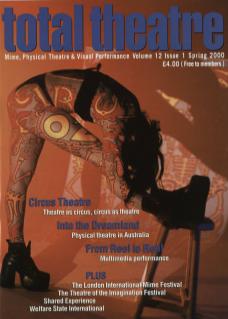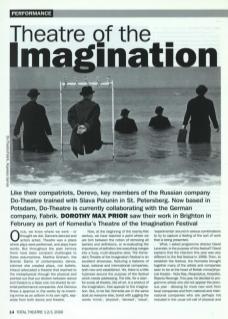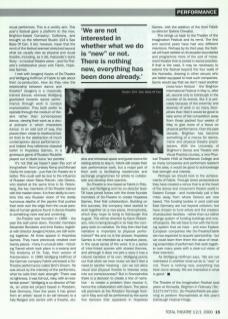Once, we knew where we were – or thought we did. Dancers danced and actors acted. Theatre was a place where plays were performed, and plays have words. But throughout the past century there have been constant challenges to these assumptions. Martha Graham, the Grande Dame of contemporary dance, claimed she created plays, not ballets. Artaud advocated a theatre that reached to the metaphysical through the physical and pointed out that our division between dance and theatre is a false one not shared by oriental performance companies. And Decroux threw a spanner in the works by reinventing mime as an artform in its own right, separate from both dance and theatre.
Now, at the beginning of the twenty-first century, we have reached a point where we are torn between the notion of removing all barriers and definitions, or re-evaluating the importance of definition lest everything merges into a fuzzy, multi-discipline stew. The Komedia's Theatre of the Imagination Festival is an excellent showcase, featuring a balance of local, national and international companies, both new and established. Yet, there is a little fuzziness around the purpose of the festival which needs addressing. The title, for a start – for surely all theatre, like all art, is a product of the imagination, that appeals to the imagination. But, to be fair, Komedia are in the same boat as everyone else, bored with juggling the words 'mime', 'physical', 'devised', ‘visual’, 'experimental’ around in various combinations to try to capture a feeling of the sort of work that is being presented.
What, I asked programme director David Lavender, is the purpose of this festival? David explains that the intention this year was very different to the first festival in 1999. Then, to establish the festival, the Komedia brought together many of the artists and companies seen to be at the heart of British mime/physical theatre – Nola Rae, Peepolykus, Hoipolloi, Rejects Revenge. This year, he decided to programme artists who did not appear the previous year – allowing for more new work from local companies and from national and international companies who are perhaps not included in the usual roll-call of physical and visual performers. This is a worthy aim. This year's festival gave a platform to the new, Brighton-based Company: Collisions, and brought us the reformed Studio 104's See Base Of Can. It did, however, mean that the remit of the festival seemed stretched beyond what we usually view as physical and visual theatre, including, as it did, Kaboodle's Soho Story – a musical theatre piece – and Do-Theatre's collaborative piece with Fabrik, Hopeless Games.
I met with Jewgenij Koslov of Do-Theatre and Wolfgang Hoffman of Fabrik to talk about their co-production. How do they view the relationship between dance and theatre? Jewgenij is a classically trained dancer, whereas Wolfgang gravitated towards dance performance through work in contact improvisation. They both prefer to operate through the medium of theatre rather than contemporary dance, viewing their work as a visual scenario in which characters dance. In an odd sort of way, this places them closer to traditional ballet than to the abstraction of much contemporary dance performance – and indeed they reference classical ballet in Hopeless Games, in a grotesque game of Russian Roulette played out in black tutus 'sur pointes'.
It's not that we haven't seen this sort of thing before – from Lyndsey Kemp and Michael Clarke for example – just that Do-Theatre do it better. This could well be due to the influence of Russian clown Slava Polunin. Like Derevo, who started at the same time in St Petersberg, the key members of Do-Theatre trained with the master clown. It is their ability to combine this very Russian vision of the darkly humorous depths of the psyche that pushes their work over the edge from the usual parodies of human gesture found in dance-theatre to something more real and unnerving.
Do-Theatre was founded in 1989 – the year the wall came down. Founder members Alexander Bondarev and Irina Koslov, together with director Jewgenij Koslov, are still working together. All three appear in Hopeless Games. They have previously created over twenty pieces – many in unusual sites – including Transit which took place in a swamp and The Anatomy of Dr. Tulip, their version of Frankenstein. In 1995 Wolfgang Hoffman of the German company Fabrik witnessed a Do-Theatre performance called Bird's Dream. He was struck by the intensity of the performers, what he calls their dark strength: 'There was no lightness, it was full-out, risky, with an existential power'. Wolfgang is co-director of Fabrik, an artist-led project based in Potsdam, East Germany. Over the years it has grown from an artists' squat in an old brewery to a fully fledged arts centre with a theatre, studios and rehearsal space and guest rooms for visiting artists to stay in. Fabrik still create their own performance work, but a major part of their work is facilitating residencies and exchange programmes for artists to collaborate and develop their practice.
Do-Theatre is now based at Fabrik in Potsdam, and Wolfgang and his co-director Sven Till have joined forces with the three founder members of Do-Theatre to create Hopeless Games, their first collaboration. Building on this success, the company have started to work together on a new piece, Kronophobia, which they hope to bring to Edinburgh this August. This will be directed by Gavin Robertson, who is being brought in to help the company work on narrative. Do they then feel that narrative is important to physical performance? Yes and no is the answer. Hopeless Games is not intended as a narrative piece, in the usual sense of the word. It is a series of interlinked scenes with shared themes, and although it does not plot a story it has a natural narrative of its own. Wolfgang points out that when we hear music we don't feel a need to ascribe meaning – can we not allow visual and physical theatre to likewise seep into our consciousness? But in Kronophobia there is a decision to create a line of narrative – to create a problem then resolve it, hence the collaboration with Gavin. The piece will premiere at the Potsdam Tanstage festival in May and will be performed by the same five dancers that appeared in Hopeless Games, with the addition of the third Fabrik co-director Sabine Chwalisz.
This brings us back to the Theatre of the Imagination Festival and its remit. The first and second years have had very different intentions. Perhaps by its third year, the festival will have settled on its broader boundaries and programme more of the sort of movement theatre that is rooted in dance practice. If that is the case, it may be necessary to extend the festival beyond the four walls of the Komedia, drawing in other venues who are better equipped to host such companies. Some would say that we don't need another cross-town festival - the Brighton International Festival in May is, after all, second only to Edinburgh in the number of its events. But it is precisely because of the enormity and diversity of work in so many disciplines that I feel it would be good to take some of the competition away from those packed four weeks of May to give more of a focus on physical performance. Over the past decade, Brighton has become something of a mecca for dance, mime and physical theatre practitioners. With the University of Brighton's Dance and Theatre with Visual Practice courses, a new Physical Theatre HND at Northbrook College, and so many companies and performers resident in the area, it would be good to acknowledge that strength and interest.
Perhaps we should look to the achievements of Fabrik. Through sheer perseverance they have created a venue that is at the heart of the dance and movement theatre world in Eastern Europe – and incidentally just a few miles away from where Derevo are now based. The funding bodies in post cold-war East Germany are not beyond criticism, but have chosen to fund artists and the creation of production facilities – rather than our rather strange system of funding buildings and one-off projects. We will have to live with the funding system that we have – and even Eastern European companies like Do-Theatre/Fabrik are now expected to acquire sponsorship – but we could learn from them the value of creating ensembles of performers that work together over many years with a clear-cut vision of their intention.
As Wolfgang Hoffman says, 'We are not interested in whether what we do is "new" or not. There is nothing new, everything has been done already. We are interested in what is good.’
The Theatre of the Imagination Festival took place at Komedia, Brighton in February. Do-Theatre/Fabrik are planning to perform Kronophobia at this year's Edinburgh Festival Fringe.


